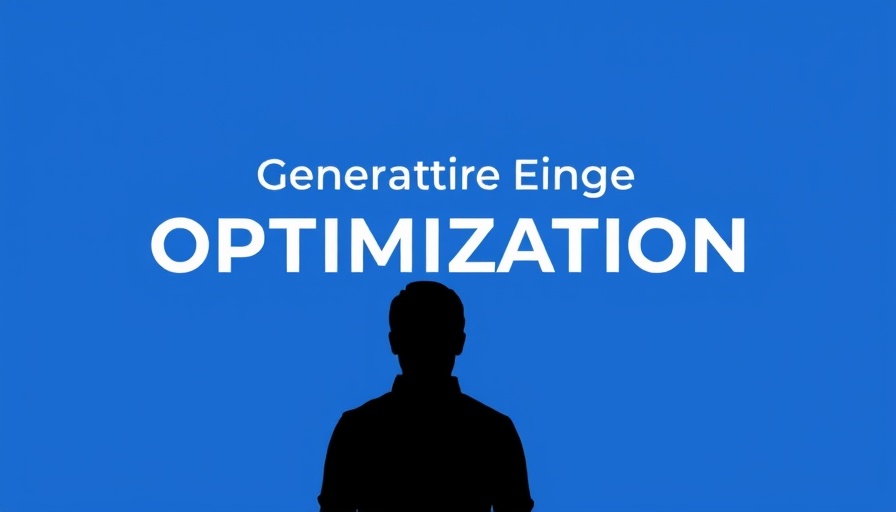
Understanding Generative Engine Optimization: A New Era for Businesses
In the rapidly evolving landscape of digital marketing, it is essential for small and medium-sized businesses to stay ahead of changes, especially as artificial intelligence (AI) becomes integral in how consumers search for information. Enter Generative Engine Optimization (GEO)—a strategy designed to enhance how brands are represented in AI-generated answers, such as Google AI Overviews and AI assistants like ChatGPT. With more than 16% of all U.S. searches now displaying AI Overviews, savvy marketers are realizing that adapting to this shift is crucial.
The Shift from Clicks to Brand Visibility
Traditionally, the goal of a digital marketing strategy was to drive clicks. Think of this approach like vying to have the best storefront on a bustling shopping street. GEO shifts this paradigm; it’s now about ensuring your brand gets recommended by AI when users search for information. As consumers increasingly turn to AI for direct answers, businesses need to focus on building brand visibility and trust rather than merely chasing clicks.
Why Small and Medium Businesses Should Pay Attention
There are substantial reasons for businesses to occupy the spotlight in AI-generated content. With AI Overviews leading search inquiries, studies have shown that when such summaries appear, websites often see a startling 34.5% decrease in clicks on the top search result. This indicates a fundamental transformation in user behavior, as more people turn to AI for immediate responses rather than traditional search results.
Leveraging Existing Strategies for AI Visibility
The good news for businesses feeling the pressure to overhaul their marketing strategies is that AI still relies significantly on traditional SEO strategies. AI assistants utilize a method called Retrieval-Augmented Generation, meaning they search established engines like Google and Bing for real-time information. If your business is already securing high rankings in conventional searches, you have a solid chance of being recognized by AI as well.
High Conversion Rates: A Silver Lining
While the volume of traffic from AI might be lower, many reports indicate that the conversion rates are drastically higher. Referring to data from Ahrefs, AI-driven traffic was 23 times more efficient at converting users than traditional search traffic. This remarkable statistic demonstrates that, though fewer people may be clicking through to a website, those that do are more likely to engage with its content or make a purchase, showcasing the fluffy potential of AI strategies.
Reassurance from Experts on AI SEO
Marketing experts, including Gary Illyes from Google, have consistently suggested that specialized “AI SEO” isn’t a necessity for achieving success with AI Overviews. In their view, quality content and solid SEO fundamentals remain paramount. The reassuring message is that marketers do not need to abandon what they already know about optimizing for search; rather, they can embrace advancements in AI while continuing to apply their existing knowledge practically.
AI Impact on Marketing Trends
As AI continues to influence marketing trends, it is fostering a new ecosystem where businesses must adapt. GEO is not about discarding prior techniques but about understanding the new landscape and ocean of opportunity it presents. In this transformed scenario, the key is to capitalize on already existing digital presence and integrate AI-oriented strategies effectively.
Actionable Insights for Your Business
So what can you do? Here are some actionable steps for small and medium-sized businesses to effectively implement GEO:
- Focus on Quality Content: Ensure that your content answers common questions that potential customers may have. This not only engages users but also improves the chance of being featured in AI answers.
- Optimize for Local Search: Enhance your presence in local search results, making it easier for AI tools to pick up your business in localized queries.
- Monitor AI Traffic: Keep track of how AI queries lead to engagements and measure conversion rates to refine your digital strategy continually.
Conclusion: Embrace the Future of Marketing
Staying informed about Generative Engine Optimization and its implications for small and medium businesses is critical in today’s AI-driven marketing landscape. By combining traditional SEO techniques with modern AI strategies, businesses can foster greater visibility, trust, and ultimately stronger engagement with their target audience. Don’t wait; start integrating these insights into your marketing strategy today and watch your business thrive in the age of AI.
 Add Row
Add Row  Add
Add 



Write A Comment